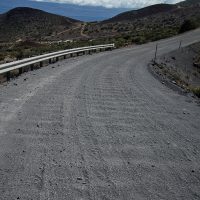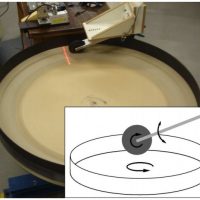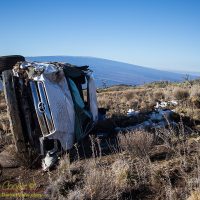It has long been policy on the Mauna Kea summit road to use four wheel drive while ascending the mountain. One of the reasons given is to slow the formation of washboard, the annoying ripples that inevitably form on gravel roads.

On Mauna Kea an oft cited mantra is that the use of four wheel drive when ascending the mountain reduces the formation of washboard. I have always suspected this is a mountain myth with no substance. Where does this belief come from? Is there any real information on this?
The Manuals
There are a great many references that detail the practical details of maintaining gravel roads. Generations of highway engineers have spent a lot of time studying and writing about how to best maintain gravel roads at the least cost.

The US Department of Transportation highway Administration has published a lengthy guide to the problems and solutions of gravel roads. This guide dedicates a dozen pages to the issue of corrugation or washboarding. While multiple factors in the formation and prevention of washboarding are discussed there is no mention of 4WD vehicles being a factor.
What about the US Forest Service? This agency maintains thousands of miles of unpaved roads. Reading through the various USFS manuals on road maintenance finds zero references to 4WD reducing washboard.
Is is the same everywhere you look, every state highway department publishes road-building manuals, they all say the same thing. Not one mentions 4WD vehicles as a solution. You get the idea they might be right.
The Science
If there are innumerable road maintenance manuals, there should be a little basic research on the subject. And there are indeed some decent papers. The study of washboard is an exercise in particle motion, a complex issue in science. Washboard is similar to some natural processes such a the formation of sand dunes or rippled sediment under flowing water.
A typical paper that presents a good study of the physics of washboard is a paper by Taberlet, Morris, and McElwaine, Washboard Road: The dynamics of granular ripples formed by rolling wheels, 2007.

Their method was to drag a wheel across the surface of a turntable. Various aggregates from different sized sands to long grained rice were placed on the turntable surface to study the effects of ripple formation.
The authors note that ripples were easy to create in their experimental setup. They were also able to create computer simulations that matched their observational results.
The wheel initially rolls smoothly on the flat granular surface. After a few tens of passes, if the velocity is high enough, a small localized ripple starts forming at some position. New ripples rapidly grow from that location, downstream from the initial position. Ripples then grow in height and eventually spread – Taberlet, Morris, and McElwaine, 2007
Examining the equations in this paper one sees that the basic forces involved can be narrowed down to wheel loading and velocity. Very little else mattered, wheel size and particle size having only weak effects.

Not to say the road material has no effect, the formation does depend on a certain depth of particles being mobilized. Thus the material must be loose and mobile, otherwise only a plastic deformation is experienced and no washboard will form.
Indeed, the formation of washboard was found to be a very robust phenomena, occurring across a wide range of particle size, wheel loading and suspension characteristics. It was almost impossible to prevent.
Washboard road will no doubt continue to annoy drivers for as long as there are unpaved roads and wheels to roll over them. – Taberlet, Morris, and McElwaine, 2007
An argument Against 4WD?
Obviously, the papers do not directly address the 4WD issue. But from the information one can propose other possibilities. The Taberlet experiment uses an undriven wheel, thus particle motion is in the direction of travel, the wheel effectively drags the particles along..
When a wheel is driven the particles still migrate and form the ripples, simply the direction of migration is changed as the force is reversed.
It is possible that all driven wheels, such as full time 4WD, would form washboard more quickly than alternating driven and undriven wheels. If anything this could be an argument not to use 4WD when ascending Mauna Kea. An interesting question for further experiment.
As for descent? Brakes apply force to all four wheels, there is no choice here.
Solutions?
What can be done to reduce washboard? The two factors often cited in road maintenance publications which concern washboard formation are driving habits and gravel quality. Both of these are borne out in the theories presented in the research.
Acceleration and braking both cause more particle movement in the surface, increasing the formation of washboard. Unfortunately on a steep road these are unavoidable, particularly in the sharp switchback curves where the worst washboard occurs.
There was one solution that appeared in several references including in the Taberlet paper… Washboard will not form if vehicle speed is kept low, very low, under speeds of 5 to 8kph (3 to 5mph). Another author noted that India has very little trouble with washboard on tens of thousands of miles of gravel road, but that average vehicle speed on these roads was very low.
As is observed on actual roads, we found a critical value of the driving velocity vc below which the bed remains flat. We find experimentally that vc ≃ 1.5 ms−1, a value quite similar to that found for real roads – Taberlet, Morris, and McElwaine, 2007
While very effective at reducing washboard, keeping the speeds this low on Mauna Kea is an impractical solution, at this speed the eight mile journey to the summit would take over an hour and use far more fuel per vehicle trip.
As road builders and maintenance crews are very limited in what they can do about diving habits, what can they do? Use the right gravel. Soft, dry aggregates and roadbeds are far more more prone to washboard. Exactly what much of the Mauna Kea Access Road consists of, pulverized cinder making up much of the roadbed.
The road building guides go on at length about gravel size and mix. A good gravel with the right combination of coarse and fine particles can reduce the formation of washboard.
Unfortunately we are likely to see little change here. While few more loads of good crushed gravel would improve the road, limited MKSS budgets and priorities make this solution unlikely.
The Mauna Kea 4WD Myth

The bit about 4WD vehicles preventing washboard? Yeah, probably a complete myth. How to get people to stop repeating this myth? That may be as difficult as preventing washboard on the Mauna Kea Access Road.
Where does the myth come from? It is true that 2WD vehicles can damage a road in ways that a low gear 4WD does not. On very steep sections of unimproved road it is not unusual to find small pits carved by the tires of vehicles. These occur when the tires spin and dig a pit in the road.
These pits are an obvious feature and only occur on very steep sections of road, usually road with no proper aggregate or simply dirt. The summit road does not have this problem as the grade is quite reasonable. Has this issue somehow morphed into causing washboard?
This leaves the real question… Are 4WD vehicles justified?
A good argument can be made as 4WD vehicles tend to have better brakes, transmission coolers, and are more robustly built than light passenger vehicles. 4WD light trucks are engineered for hauling loads, towing, and off-road use.
On the summit the air pressure is 40% less than at sea-level. This means that radiators do not cool as well, transmissions and brakes get hot, and stay hot longer. Combine that with the long grades and you need the extra capability provided by most trucks.
And this is a valid reason… 4WD trucks have the extra safety margins that make a real difference on the mauna. Certainly some 2WD pickups and light trucks have these features, but you must make a distinction somewhere to differentiate the wide range of vehicles that might attempt to ascend the mountain.
While four-wheel drive vehicles are strongly recommended, many motorists ignore that recommendation, and drivers may not know how to safely operate their vehicle, especially on the steep, downhill return from the summit. – Mauna Kea Comprehensive Management Plan- Public Access Plan, January 2010, page 2-31
Drawing the line at 4WD vehicles most likely provides a significant improvement in the safety situation due to the inherent robustness of such vehicles. If a justification needs to be made to limit summit traffic to 4WD must be made, this is the sensible and honest answer to give.
References
Problems Associated With Gravel Roads, US. Department of Transportation, Federal Highway Administration, Publication Number FHWA-SA-98-045
Washboard road: the dynamics of granular ripples formed by rolling wheels, N Taberlet, SW Morris, JN McElwaine, Physical review letters, 2007
Scaling and dynamics of washboard roads, AF Bitbol, N Taberlet, SW Morris, JN McElwaine, Physical Review E, 2009


That’s very interesting. Here in puna HPP we have base coarse 3/4 gravel and also red cinder
The cinder roads are heavily washboard after 3 week’s and don’t usually have pot holes
Where the 3/4 base has potholes and no washboard.the speed limit it is 15 mph
We find its the cars over 20 mph that do the damage here
It would seem the frequency response of the vehicles suspension is the most significant factor. Low speed merely lessens the oscillation of the vehicle’s suspension.
The wheels mass and suspension affect the pattern, but not whether ripples will form…
“The mass of the wheel and its suspension strongly affects the pattern. Heavier wheels produce larger amplitude ripples with shorter wavelengths.” – Taberlet
A Fourier decomposition of the pattern would be interesting.